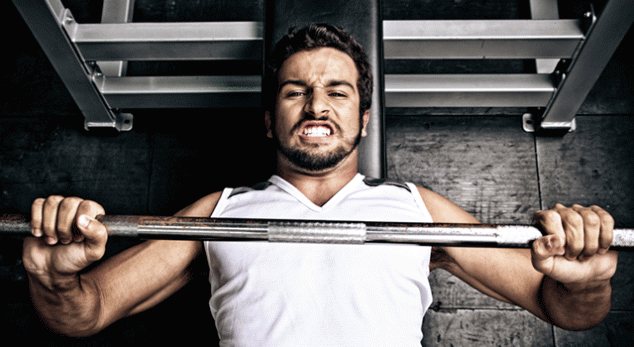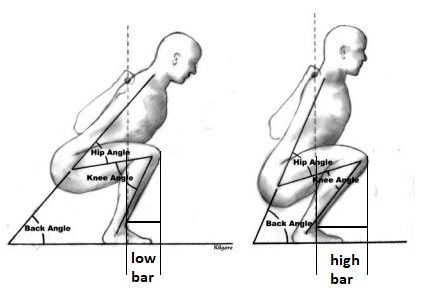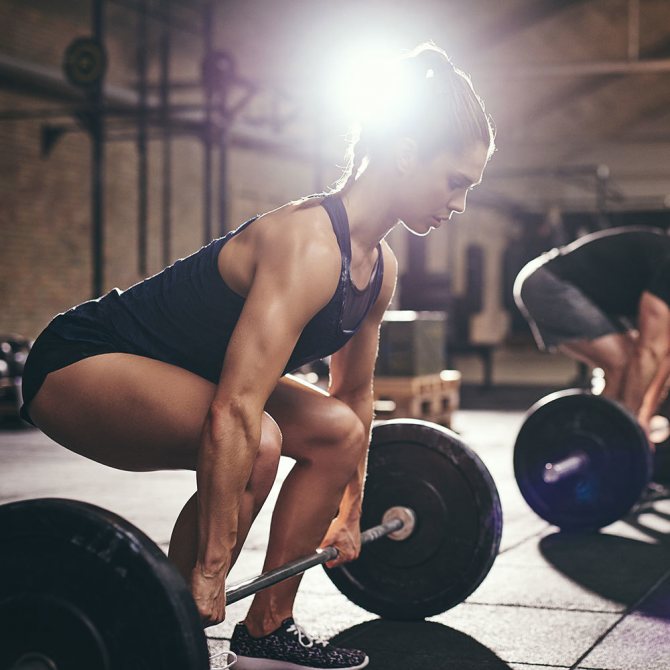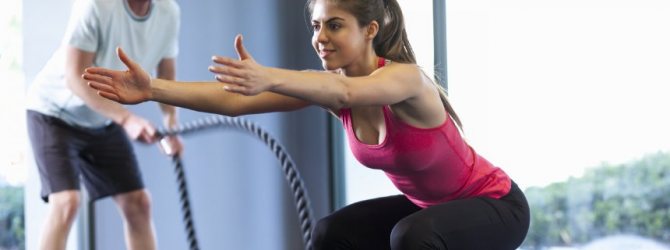
According to most athletes, squats and deadlifts are two parts of one integral process, therefore, which one is better is an eternal question, since it is quite difficult to separate them in principle. However, many beginners are concerned about this issue, as they want to achieve the desired results faster, but have some difficulties in approaching the sports program. In this article, we’ll take a look at each exercise separately and learn all the benefits of exercise, and conclude which is better: squats or deadlifts.
Exercise relationship
It is known that there is a definite connection between the squat and deadlift. These two exercises are basic in strength sports, they develop the muscles of the back and legs, and at the same time perfectly complement each other in training. In addition, a similar execution technique is traced in these exercises. The athlete needs to keep the thoracic and dorsal sections straight in both cases.
In squats, the legs get a load of about 60%, and the back – 40%. The deadlift provides 60% tension to the back muscles and 40% to the legs. When the legs are trained in squats, the effectiveness of the deadlift increases, the same thing happens the other way around. The opposite effect can be fond in this way: if you do not squat, then the deadlift will be given poorly. On the other hand, without the deadlift, building your glutes and legs will be more difficult. Both exercises give a good load on the following muscle groups: the external and internal muscles of the thighs, abdomen, back and lower leg.
From this it becomes clear how almost the entire body of an athlete is strained when performing a deadlift or squat and why it is so difficult to isolate the exercise that will do more good.
High Bar Squats
The bar is placed on the trapezius muscles, while the arms squeeze the bar, the back muscles contract to support the weight, at the same time in parallel with this, the muscles of the core begin to contract to stop the body from falling forward. The athlete then simultaneously flexes the knees and hips, transferring the weight to the quads and glutes. The lifter, having reached the bottom point and maintaining the straight position of the back and legs, set at the beginning, returns back, contracting the quadriceps and buttocks.
In general, this explanation of the mechanics of squatting is just the basis for how to perform squats. It’s actually a little more complicated.
You have to consider foot position, foot angle, core stability, forward knee movement, etc.
Squat, repeat is an exercise that requires close attention to technical execution, you better (even need to) take the time to master the technique before trying to lift heavy weights. Once the technique has taken hold (under the supervision of a trainer or a more experienced gym colleague, of course) and become second nature, increasing the load you lift should take priority.
Compared to the back squat, the high squat positioned bar leads to greater activation of the quadriceps muscle. It is also more burdensome for the lower back as it has to work harder to maintain a more upright position.
A key difference between the two types of barbell squats is that when placing the bar on the trapezius, the squat involves more knee movement forward. This basically means that the knee should move further in front of the leg, thus moving further away from the center of gravity.
This has several consequences:
First, More forward knee movement means it is easier to squat below parallel in the squat. The squat is deeper.
Second, the quadriceps are the main muscles involved in this straight knee movement, so they are more activated. The quadriceps are trained better.
On the downside, there is a greater load on the knees compared to squatting with a low bar. The athlete must also have sufficient ankle mobility to successfully complete the squat.

Left to right: Back angle, Hip Angle, Knee Angle ). Low Bar High Bar
In most cases, this results in athletes being able to lift less weight with the bar on their shoulders than squatting with the bar on the back deltas .
See also Less intense activity for those who hate burpees: emphasis on hands
This nuance can be either a plus or a minus, depending on the goal. If you are a bodybuilder looking to build, work the quadriceps, or a weightlifter who masters a clean high barbell seat is technically ideal as it maximizes the activation of the quads without transferring maximum load to them, the disadvantage is obvious – if you want to take heavy weights, you will have to position the barbell lower.
Major mistakes: poor ankle mobility and hips. If these issues are not resolved, the correct orientation of the body in space for squatting cannot be achieved (NO!), And the risk of injury increases. It’s important to take the time to assess and address mobility issues before attempting to progress squatting.
Deadlift

Which is better, squats or deadlifts? To understand this issue, you should consider each exercise separately and identify the main advantages.
Benefits of the deadlift:
- Improves metabolism.
- Occurs growth of muscle mass.
- Tendons and joints are strengthened.
- Stimulates the growth of the body as a whole.
- Almost all muscle groups are stressed.
This exercise distributes the load throughout the body. Leg and gluteal muscles, abs and lower back, trunk are being worked out. The classic deadlift is quite simple:
1. With a slight bend of the knees, you need to bend forward, grab the bar.
2. The back bends slightly in the lower back, while the chest and shoulders are straightened. The bar is lifted up to the lower leg.
3. From this position, you need to slowly raise the bar up, without bending your back or leaning back.
4. Then, pulling your pelvis back and bending your knees, lower the machine.
5. At the last point, the hips are tightened, and the bar is lifted up again.
This exercise is the most standard of the other deadlifts, but it works on the wide muscles of the back, hamstrings and triceps.
Deadlifts can also be performed using dumbbells, this option is the safest compared to the previous one, and the working effect is noticeable no less.
Technique
Head position. Never look under your feet while squatting. When the head is tilted forward, the back will begin to round accordingly, leading to injuries. It is necessary to look forward while squatting, or slightly raise your head up
. In this case, the back will be straight, and the correct deflection is formed in the lumbar region.
How to take the bar. You can squat with different arms. The projectile is taken both narrowly and with arms spread wide. In the initial stages, we recommend taking the barbell slightly wider than the deltas. In bodybuilding, it is customary that the bar should lie high enough towards the neck and traps
. Powerlifters put the bar much lower, this allows them to squat deeper and engage the gluteal massifs.
Let’s go back to the cultural squat with a bar and put the bar high enough and lay it on the deltas.
Back and knees. The back should be straight with a bend in the lower back so that the muscles contract correctly and you do not get injured.

When squatting with a bar, watch your knees, and do not let them go beyond the socks, which must always be ahead of the knees. This is done in a practical way – it is necessary to take the “ass” back. When the buttocks are pulled back, it allows our body to lean forward so much. If the “butt” is not put aside, the knees will go beyond the socks in the first phase of the movement.
Heels and toes. When squatting with a barbell, the socks should look to the sides and parallel with the knees, in the same plane. You need to squat smoothly and without jerking. When rising, exhale, when lowering, inhale.
Never tear off your heels. All the mass and efforts should go into them, and be repelled by them. There should be a place in the lower range of motion under the socks so that you can put the newspaper and stick it out.
Bodybuilding squats do not involve full extension of the knees. You don’t need to straighten your legs at the top
. It is necessary to keep the leg muscles in tension and control the load.
The sequence of the exercise.
Squats

The benefits of squats are pretty impressive in any sport. This exercise helps:
-
- Growth muscle mass.
- Burn fat.
- Mobility.
- Improve coordination.
- Increase efficiency.
- Prevent injury.
- Center body development.
- Strengthen joints.
- Increase flexibility.
- Improving endurance.
From the above list of benefits, you can see that this universal exercise is of great benefit, which is why it is considered the basis of all workouts.
Correct doing squats:
1. The body is in a straight position, the legs are slightly wider than the shoulders.
2. Taking a deep breath, bending your knees, slowly lower yourself to 90 degrees to the level of your hips.
3. With an exhalation, return to the starting position. Perform 20 times in one approach. The number of approaches increases depending on the state of the body.
Comparison
Choosing between squats or deadlifts is not accepted. But there are times when you still need to choose.
Standing will be an alternative option in the event of an injury limiting the scope of movement. With the right approach to training, thanks to this exercise, you can achieve good results without full squats. During barbell lifts, the quadriceps area is less loaded. Therefore, if discomfort is felt during squats, many athletes exercise in the deadlift. This is the case when deadlifts are performed instead of squats.
Squats, in turn, play a huge role in training for any athlete. This improves the hip joint and other lower joints.
Afterword
Today we finished off the second part of the Bar Squat article. In the course of it, a bunch of practical points were sorted out and the most common myths were dispelled. Now you can safely, without any ulterior motive, indulge in this exercise :). So, are you ready to commit this unceremonious act? Then let’s blow into the gym, good luck!
PS. Friends, do you use squats in your training program?
PPS. Did the project help? Then leave a link to it in the status of your social network – plus 100 points to karma, guaranteed.
Which is better
Each exercise has its advantages but how do you decide which is better – squats or deadlifts? The difference between the two similar and important exercises is as follows.
Beginners should only perform deadlift exercises with light weights. When the muscles are stronger, you can increase the weight, usually after six months of vigorous training. Squats do not require any special preparation.
Experiments are not recommended in the early stages. Traditional technique must be followed. Squats can be done in different conditions and variations.
Deadlifts are dangerous for the untrained, especially for lean people with fragile muscles. Squats do not require experience and are suitable for everyone, have a strengthening effect in different forms.
Squats and deadlifts have little difference. To understand which of them is most suitable, you need to understand the ultimate goal of training and monitor the correct distribution of the load. By mastering many squatting techniques, the lower back can be developed perfectly, while the deadlift will strengthen the body almost completely. We must not forget that the exercises are related to each other and the best result will be achieved when they are combined.
